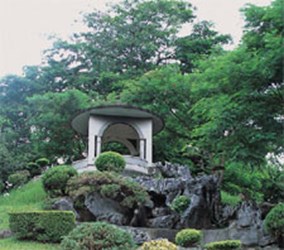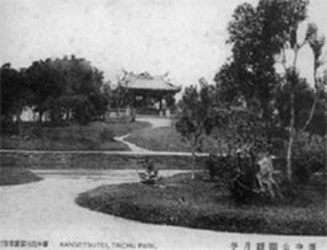Words and Photos by Lin Liang-Zhe
Translation by Cara Steenstra
There are not that many places in Taichung City that are from "long long ago". Yet "DaDun" could be said to be one of the few historical sites of Taichung. Long before Taichung City was established, there have already been signs of human activity in this area, these people left their mark behind amongst the ruins. More than 200 years ago, the first group of Han Chinese immigrated and settled here. Though ravaged by war, the city had slowly begun to take its shape. And over the last hundred years, Taichung City has developed into a metropolitan city with a population of over a million people. And "DaDun" can be said to be the origin of this city, and Taichung City is often known by this other name of DaDun. Yet all the stories that originated from here, all started from long, long ago…
Exploring the origins of Taichung through the ruins of Taichung's shrines
Situated inside Taichung Park, the landmark of "DaDun" might be just a small mound of land, yet when you look back on the pioneering history of Taichung City, you will discover its significant place in history.
Over 3000 years ago, humans have settled around the area of DaDun, remains of tribes, housing, clay products and stone tools were found in the area. In 1910, archeologists discovered what is now known as the "Taichung Shrine Ruins" (the shrine no longer exists, and the place is now known as the "Taichung Park Ruins"), and up until last year (2004), many clay pieces and various stone tools were still discovered in the area.
During the Qing Dynasty Yong Zheng period (around 1720), another settlement arrived here. Han Chinese came here from Mainland China; they discovered that this area was geographically situated on higher grounds, thus it was able to avoid devastation by floods. This was why they chose to settle and build a temple here. Since the land mound here is on higher grounds than other areas, it came to be known as "DaDun" ("da" meaning big in Chinese, and "dun" means mound). And around 1764, a street was established here and came to be known as "DaDun Street".
At the time, the development of Taichung City began from specific points. Apart from DaDun Street, there were also settlements at "Li Tou Dian Street" (now known as NanTun Lane of NanTun District), "Shi Zhang Li Zhuang" (now known as RenMei Lane of BeiTun District), "Qiao Zai Tou Zhuang" (now known as South District), "He Cuo Zhuang" (now known as XiTun District's HeCuo Lane) and others. Amongst these streets, DaDun Street and LiTou Street were most populated. In 1786, the "Lin Shuang Wen Incident" and in 1862, the "Dai Chao Chun Incident" turned DaDun Street into a battlefield and the area suffered from terrible destruction, it was not until 1870 that it slowly recovered. And it was also during this same period that the "West DaDun Street" in XiTun began its development, and in order to differentiate the two locations, it was named "East DaDun Street".
At that time, "East DaDun Street" was separated into Upper, Middle and Lower Street. The original location of Upper Street is where the present Guang Fu Elementary School is situated, and was where the Ma She Public Shrine was once situated, but has now been relocated to the intersection between Zhong Shan Road and Zhong Hua Road. Middle Street was where rice shops and grocery stores were located, and was also the busiest commercial center of the city at the time. There were sedan chair shops and open markets selling vegetables and fresh fish on Lower Street. And the "DaDun" land mound that was situated north of Upper Street became a graveyard, and was also the highest geographical location of "East DaDun Street".
Carrying out city planning proposals, which will preserve precious ruins
In 1887, Taiwan was established as a province, the first administrator sent here, Liu Ming Quan established his administrative offices in East DaDun Street and at Qiao Zai Tou Zhuang. In 1889, work began on a city moat, and was named "Taiwan Province City", but this plan was never completely carried out. In 1895, when Japan occupied Taiwan, this area became "Taiwan Administrative Sub-Branch", but was then changed to "Taichung County" the following year, then changed to "Taichung" a little later. In 1900, city-planning proposals began to be implemented.
During the Japanese Occupation Period, since the "DaDun" land mound was the highest point within the city district, situated 89meters above sea level; that was why the army set up cannons here, and the name was changed to "Pao Tai Shan" (literal meaning: Cannon Hill). In 1898, the "89th Third Grade Triangulation Station" was established here and it became the 'Basic Point" where Taiwan land surveys started. And in consequent city planning, the Japanese Government placed "DaDun" within the Taichung Park area. And in 1903, the original "Bei Lou Men" was relocated here, and it became one of the scenic spots in the park.
Under city development, land mounds in Taichung City were relocated. In the 1970s, "West DaDun", which was situated in XiTun, was removed for highway construction reasons. The "DaDun" that is situated in Taichung Park became the few rare "ruins" that were preserved in the development of Taichung City. Nowadays, Taichung City is a concrete jungle with high-rises everywhere, once known as the high ground of Taichung, "DaDun" has become much smaller and shorter compared to the rest of the city. Yet, in the development history of Taichung City, "DaDun" is the origin of a lot of stories, telling tales of the lives of people from hundreds of years ago, also witnessing the development of Taichung City.

 Facebook
Facebook
 Twitter
Twitter
 LINE
LINE

